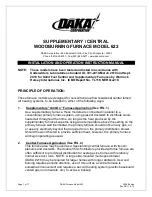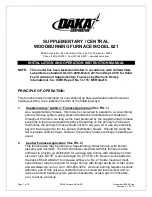
AES Technical Bulletin # F-0404 Date of Issue 02/13/2006
AES TECHNICAL BULLETIN
MagnuM 6500 Furnace Operation / Clinkering / Changes
The purpose for this bulletin is to discuss the MagnuM 6500 Furnace operation in relation to clinkering, buildup in
the firepot, what causes these things to happen and what is the solution. We have found that once customers are
instructed and understand how to operate the furnace expected results will be consistent with the design of the
unit. The installation and operations manual clearly explains how the unit is supposed to operate and what
maintenance is involved. Following these procedures will enable the operator to have trouble free operation.
The following list explains the different situations where excessive clinkering or buildup in the firepot may occur.
Remember that the MagnuM 6500 Furnace does not have a self cleaning firepot and needs to have the clinker
manually removed every 12-24 hours depending on fuel quality, quantity, installation of product and operator
habits.
1. Fuel quality: If your fuel is high in starch it is not going to burn quickly or completely. This will cause the
firepot to fill up quicker than normal. If the fuel is wet (over 15%), it will contribute to a rapid concentration
of clinkers and plugging of the air holes. If the fuel has a high test weight (over 56 Ibs per bushel), it
could be dumping more fuel into the firepot than the unit is capable of burning. This would require a fuel
feed rate test to see if this is happening. Corrective action is to make sure the fuel is dry and clean, try to
get good quality fuel as possible and every 6-8 hours knock the clinker down with the cleaning tool. You
do not have to take the clinker out right away but need to stir the fuel around in the firepot which will break
up the clinker and knock the buildup down to size. The firepot would have to be cleaned out every 8-12
hours to have proper operation.
This can be done without losing the fire.
2.
Ash buildup: It is important to shake down the ash (front shaker rod) every 8-12 hours to allow enough air
to get around the firepot. Do not wait until you are ready to empty the ash drawer. If the firepot cradle is
full of ash it will cause the air to only go into the back side of the firepot and this will cause uneven
combustion and possible firepot warping. Corrective action is to shake down the fuel every 8-12 hours
and check the ash area underneath the firepot every 1-2 days.
3.
Shaker grate not sealing: If the shaker grate is not laying right on the bottom of the firepot cradle, it will
re-direct the air out the bottom of the firepot and the fire will not burn properly. This can be caused by the
slide not manufactured properly, customers beating on it when they cannot get it to move (normally
caused by lack of maintenance) or unburnt fuel getting underneath it. Corrective action would be to
check to make sure that the slide is setting flat and correct it if it is not setting flat. This can be done
easily by tapping on the rod to bend the plate downward. Dislodge any fuel that is setting underneath the
plate. Also make sure that the customer is sliding the plate all the way back when the unit is burning.
4.
Door or Ash drawer not sealing: If the door or ash drawer door is not sealed it will take air pressure away
from the firepot. Corrective action is to do the paper test or a leak test to make sure that all gaskets are
sealing. If the gaskets are leaking, replace with new gaskets or repair existing gasket.
5. Firepot not sealing: If the firepot is not sealing against the top of the firepot cradle, the air pressure will
drop and the fire will not get enough air. Corrective action would be to grind the area that is causing the
firepot not to seal and allow the firepot to sit correctly in the firepot cradle.
Before grinding the cradle
make sure that the firepot itself is not warped.
6.
Incorrect Air intake venting: If the outside air is not hooked up or is not properly sized for the application
you will not get adequate combustion air. If there are more than 2 elbows or if the air run is more than 10
feet, you need to be using 4” air intake venting. If the venting is being obstructed, contaminated by
exhaust or otherwise not allowing correct air to the unit, you will need to change the system so that it is
correct. Testing for this would be done with an air flow instrument or you can do a preliminary test by




















